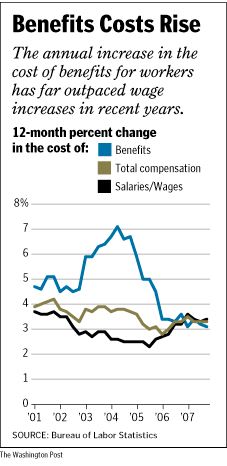As is often the case, the glass is half-empty over at the Washington Post (HT: Steve Chapman). The headline on today’s front page:
Rising Health Costs Cut Into Wages
Higher Fees Squeeze Employers, Workers
The article begins:
Recent history has not been kind to working-class Americans, who were
down on the economy long before the word recession was uttered.The main reason: spiraling health-care costs have been whacking away
at their wages. Even though workers are producing more,
inflation-adjusted median family income has dipped 2.6 percent — or
nearly $1,000 annually since 2000.Employees and employers are getting squeezed by the price of health
care. The struggle to control health costs is viewed as crucial to
improving wages and living standards for working Americans. Employers
are paying more for health care and other benefits, leaving less money
for pay increases. Benefits now devour 30.2 percent of employers’
compensation costs, with the remaining money going to wages, the Labor
Department reported this month. That is up from 27.4 percent in 2000.
So the point is that because of rising health-care costs, workers are worse off. Pretty depressing. And there’s a graphic to help make the point:

Unfortunately, the text accompanying the graphic is a non-sequitur–"The annual increase in the cost of benefits for workers has far outpaced wage increases in recent years." That sounds bad. That sounds like the costs of health care is growing faster than wages and higher health care costs would seem to imply a lower standard of living for workers. But it doesn’t imply that at all. It simply says that the benefits component of compensation has been growing faster than the wage component.
And what does it mean that the "cost of benefits" is rising? What does the word "costs" mean in that phrase? It’s a cost to employers. But to workers, benefits are, well, benefits. Higher compensation. What the chart shows is that benefits have been rising rapidly. That’s actually a good thing. Yes, part of that increase is that employers are covering health care costs that have been rising. But it also includes other types of benefits, forms of compensation that are usually tax-free to employees.
To find out whether workers are doing better or worse than they once did, you want to look at whether total compensation is growing faster or slower than inflation. Look at the graphic–it shows that other than a couple of months at the end of 2005, total compensation has been growing between 3% and 4% a year since 2000. But between 2000 and 2007, the CPI increased about 20% or less than 3% per year. So real compensation has been rising.
It’s not clear from the graphic whether this is compensation per worker
or per hour or whether it’s total compensation across all employees. So the conclusion could be distorted by increases in the labor force since 2000. But what is clear is that the graphic has nothing to do with the pessimism of the article and seems to refute it.
As for the 2.6% fall in median income since 2000, the one seemingly hard piece of evidence in the article, if the number is from the Census (which I assume it is), the Census income figures don’t include health care benefits or employer contributions to retirement. So those income figures tell us nothing about the role of rising health care costs’ effect on the standard of living of the median worker.
The rest of the article is a series of anecdotes about how expensive health care is. There is no hard evidence for the central claim that rising health care costs have reduced the standard of living of the average American. In fact, the graphic implies the exact opposite.



